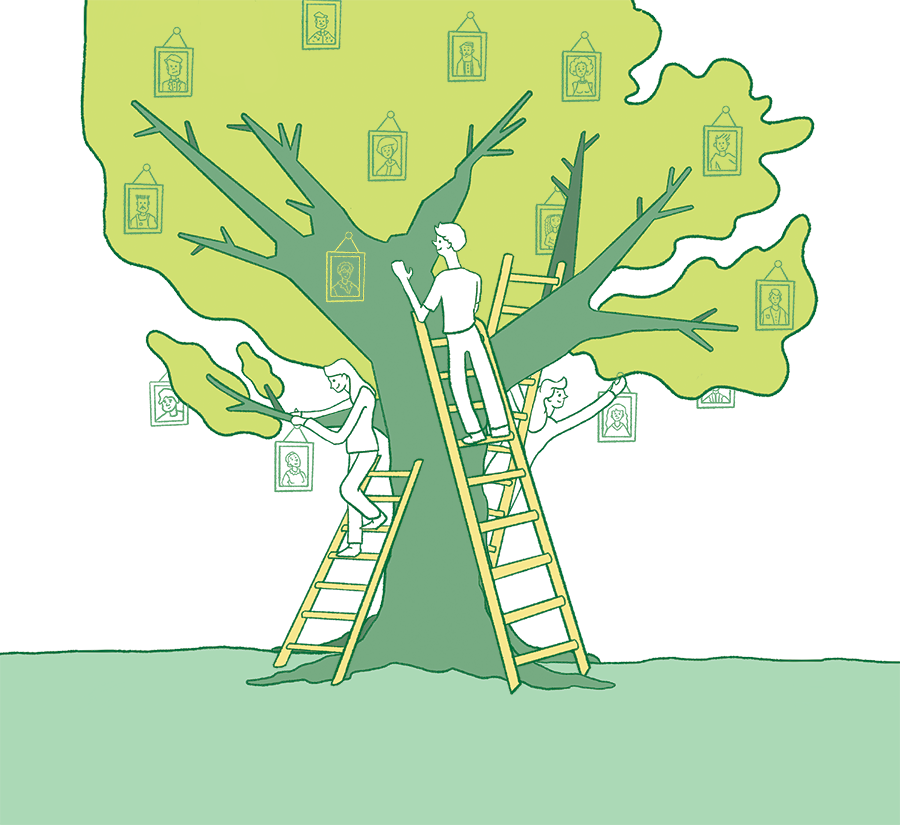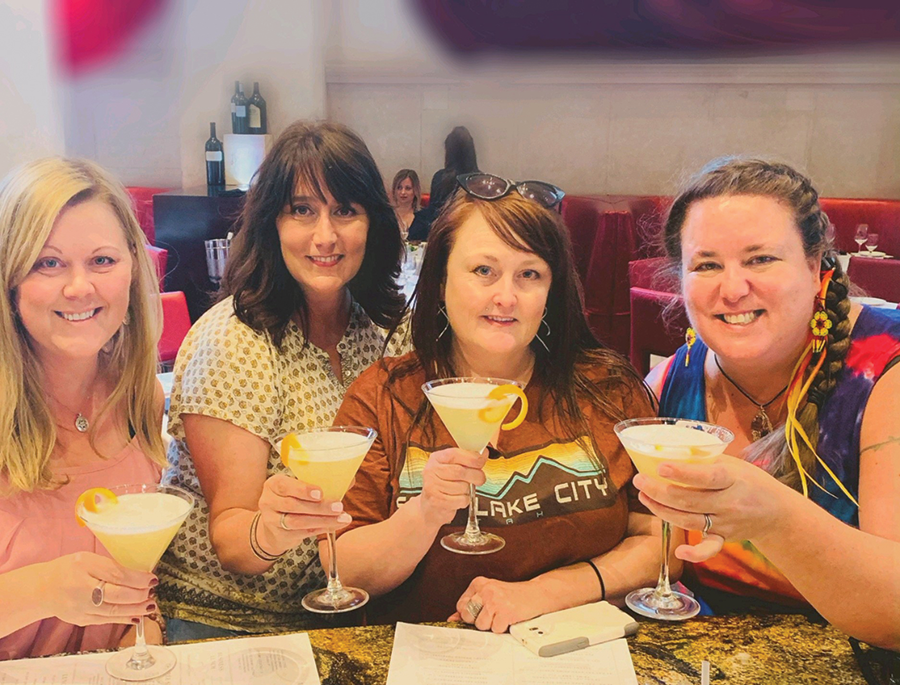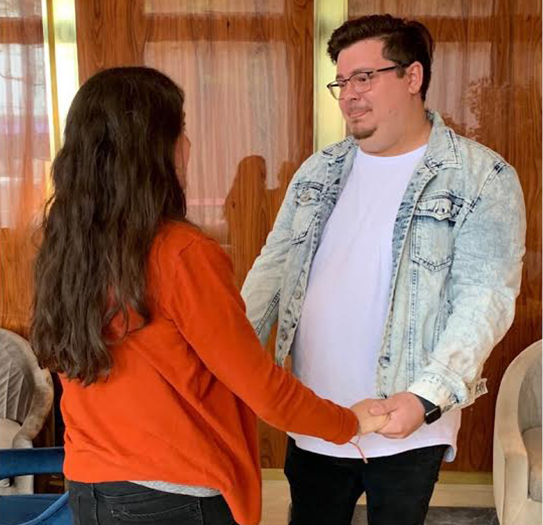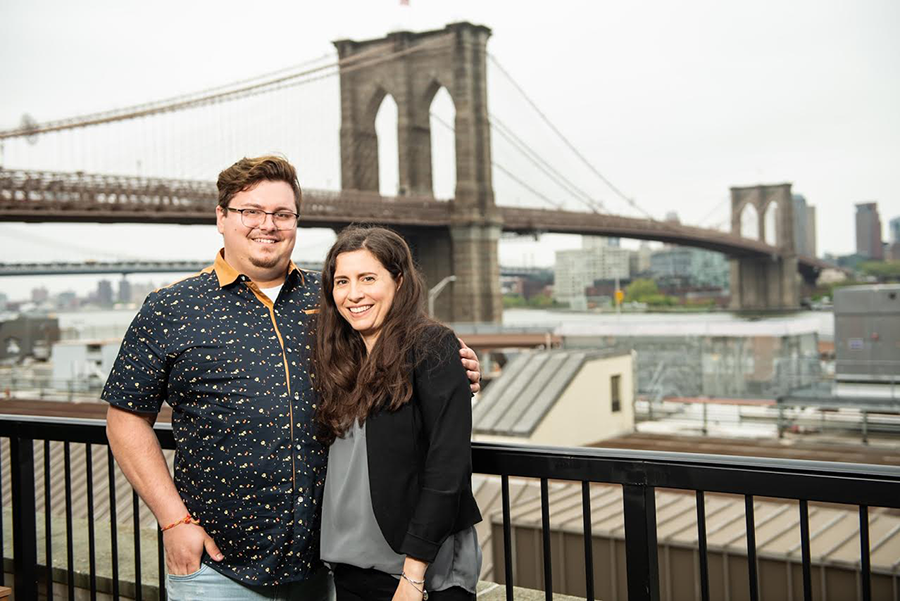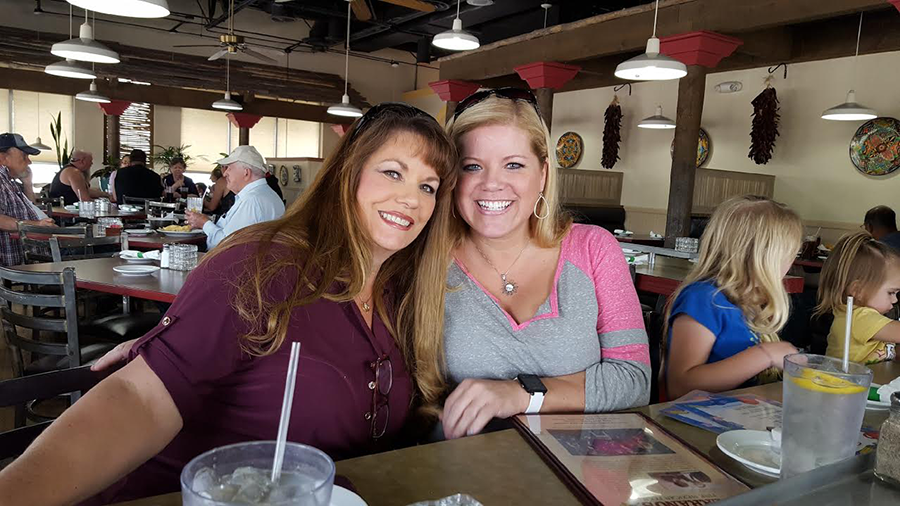Year
Kathy Mueller carried a greeting card in her purse for more than a month. She took it to work and brought it back home. She sensed that mailing this particular card could change her life. It was addressed to a woman she'd never met. The two share a connection as close as blood: the woman is her birth mother.
In 1968, Mueller was 10 days old when she was adopted from a Salt Lake City agency. Her birth parents were a rare subject of conversation when she was growing up. She was told that they were college students living in Colorado, "who couldn't deal with a baby, so I was given up; I've since learned that story is partially true. I was raised with the belief that I could never find them," she recalls. She mostly thought about her birth parents in moments when she felt disappointed or angry with her parents. "I would think, 'Maybe I can just find my real family,'" the redhead says. Still, she doesn't feel like she missed out on anything in the home where she was raised. She was close to her grandparents and often helped her grandfather work in his yard. "The biggest compliment he gave me was that I worked like a boy." Her father, she says, really loved her younger sister, who was "his precious, pretty little doe-eyed girl, where I was a sturdy Irish girl who was lippy and stood up for myself."
Yet, once she had an epiphany that he would never be the Dad she wanted him to be, from her perspective their relationship changed—they got along famously. Their association became a loving one where he dined at Mueller's home almost every week. He loved to hang out with her husband and sons. Her father was later murdered in 2002. "I still have my Mama," Mueller says about her mom, Ruby Kohtz. "She is 82 years old and totally badass. I adore her. It wouldn't matter when and if I ever meet my birth mother. No one could ever replace her."
Shortly after Mueller's son was born in 1989, she wrote to the adoption agency. A social worker suggested she sign a paper authorizing members of her birth family to contact her, adding that her birth mother might have signed a similar paper that could now be in Mueller's adoption file. She followed suit, but didn't take the process further. She wasn't sure how she felt about opening the Pandora's Box of actually contacting her birth family. "Stability has always been something that I seek out and crave," Mueller, now a City Weekly account executive, says. Her adoptive family was stable. "I just kind of glommed onto my adoptive family's history; it became important to me. I tried to own it as much as I could, but still, inside, you know it isn't you."
She then created her own family, giving birth to two sons, Austin and Dylan, in 13 months. "They are now 29 and 30—my Irish twins," Mueller boasts. "For the first time in my life, I had these people that I knew were my people. We have the same blood and are cut from the same cloth. I'm totally addicted to my sons. Neither of my parents were very outwardly emotional people. I've always been touchy-feely and made sure my kids were showered with affection."
Six years ago, Mueller's mother-in-law gave her an Ancestry DNA test. She left it sitting around for about a year. "I didn't know if I really trusted it," she says. "I wondered if it would open a can of worms." Then, one night, when she and her husband were laughing together, "I decided what the hell, I'm doing it," she recalls. "I love red wine. I'm sure there was a fair amount of red wine in the saliva sample that I submitted." She felt like she took the test mostly to confirm her lineage. The initial results showed that she was mostly Irish, then English, with 9% from the Iberian Peninsula. The results showed a couple of second cousins who had included photographs, which Mueller looked at a couple of times. "I would wonder if maybe I looked like that, or if my nose looked like that." Later, she received a report from Ancestry stating that their science capabilities had been updated and that the most current report stated that she was 68% Irish and 32% English.
On Jan. 13, 2019, Mueller was "luxuriating in bed, drinking coffee and checking emails," when she spotted an email from Ancestry. The man who wrote it said she showed up as his first cousin. He was trying to help his father figure out his own story. Mueller wrote back that, being adopted herself, she thought she wouldn't be of much help. "I was honest with him, telling him I'd never really sought any of this information out and he was the first contact I'd had."
Mueller and her newly found cousin, Duke, hit it off from that first exchange. "It opened up the floodgates for me. We had this instant dialogue from the minute he emailed me. We probably sent 20 emails that first day. I was trying to upload a photo of myself to send to him, when he said, "My wife is the queen of Facebook stalking. She looked at your Facebook page and we totally think you look like our family." She admits she felt fleetingly violated, but, "from the beginning, our banter was easy. I had these moments while we were corresponding that felt like [we had revived] the lost art of being pen pals. I was receiving kindness and generosity—basically from a stranger," she says. Duke eventually invited Mueller to visit him and his wife in Philadelphia. Mueller asked herself, "Do I want to take this relationship to the next level and meet in person?"
While deliberating whether to travel to Philadelphia, Mueller acquired additional information about her own story by requesting a redacted version of her file from the adoption agency. "For the first time, I knew where I was born, how much I weighed as a baby and how long I was," Mueller reminisces. The file said that Mueller's birth mother didn't tell anyone she was pregnant, including the baby's father. She was a 20-year-old BYU student. "Reading the case worker's notes, I saw that [my birth mother] was raised Mormon, but had kind of strayed from the church. It said that my grandmother felt that she hadn't done right by her children because they weren't inclined to the Mormon faith." Mueller adds, "I have to give her credit for carrying out a pregnancy stealth-like, where she disappeared for less than three months, gave birth and went back to her parents in Pocatello." From the file information, she figured out which year her birth mother graduated from high school. Reading her birth grandmother's obituary, she discovered her birth mother's married name. "Then Facebook made things really easy. Once I saw what she looked like, I felt a sense of urgency." She wrote her birth mother a Facebook message, then decided to wait to send it.
Mueller's first face-to-face meeting with her cousin, Duke, in May when she and her two best friends traveled to Philadelphia. "We spent four days together. The conversations really flowed. Although he's very East Coast and I'm very West Coast, we have the same sense of humor." At the end of the visit, Duke told Mueller, "No matter what happens, we got you out of the deal."
Mueller later found additional connections between herself and her birth mother. Looking through their mutual friends on Facebook, she said, "It turned out that two of our mutual friends are relatives of my ex-husband." Recently, a person with connections to Mueller and her birth mom called her to say that her birth mom had died. "I felt the heaviest regret I've ever felt—that she was at my fingertips. I had been so close to expressing my gratitude and I didn't reach out," Mueller says.
A few days later, the person called to say that she had been confused—it was actually Mueller's birth mother's sister-in-law. Mueller took the greeting card and headed for the sister-in-law's funeral. "I saw her right off," she says, of the moment she caught sight of her birth mother. "But she was in a group, and I thought if I could catch her alone, I could give her the card. Then, I saw that she didn't have a purse with her, so I thought I couldn't give her the card." Moments later, her birth mother walked past and picked up her purse. "I thought, 'This is my moment.' I grabbed my card and stopped her, saying, 'You probably don't remember me, but I have this card and I would like you to read it when you have complete privacy." Her birth mother asked her name and Mueller said, "I'm Kathy. Here's a card; I'd like you to read it when you're alone." Looking back, she says, "I was trying to fly under the radar and not be really obvious. I gave her a hug and left as fast as I could." Today, she is grateful that she got to tell her birth mother thank you. She says it doesn't matter if she ever hears back from her.
A Familiar Tale
For genealogists and people seeking their roots, DNA testing has become a game changer, making many more connections possible as increasing numbers of people continue to take at-home tests and add their information to online family trees, says SLC native Mckell Keeney, a genealogist specializing in DNA. "If you watch any of the popular TV shows on genealogy, such as Long Lost Family, Relative Race or Finding Your Roots with Dr. Henry Louis Gates, they're all about stories of searches and reunions. They're not always 'fairy tale' encounters—not at all—but establishing connections provides people with peace and a greater sense of self just to discover information such as, 'What was the name of my biological father?' or 'What did my biological grandmother look like?'"
In Keeney's adopted brother's case, she said, "When our parents passed away, he felt lost, because he was so close to them." After he took a DNA test, Keeney was able to figure out who his birth mother was, even though she was adopted herself, and went back a "second generation to puzzle out the rest of his line." She says her brother—and many other fellow adoptees—feel that their adoption wasn't a mistake and they were actually raised by the right people. "The siblings he found told him that he was the lucky one that got away. They knew he was placed for adoption—their pregnant mother went to the hospital and came home without the baby. She told the other kids to tell people he was stillborn," she says. Mueller adds that it is emotionally healthy to be able to trace one's biological genealogical line whether or not a person actually makes contact with newfound relatives.
Regarding the debate over which weighs heaviest—nature or nurture—"I am blown away all the time about what is passed down through DNA," Keeney says. She worked with biological half-brothers who had never met, yet sounded exactly the same on the phone. "They even used the same phrases. I would have to ask myself if I was speaking with John in Seattle or his brother, Scott, in Virginia."
Jacob Thornton and Natalie Stevens
Jacob Thornton's personal history began with a gray area. His life was like a book that started on Chapter Two. He had no idea what happened in the first one. Still, he had a great life with the couple who adopted him as a baby. "My real parents were the ones who changed my diapers and wiped my runny noses," he says. His adoptive parents, who traced their own provenance directly to Brigham Young, also understood he might someday want to find his biological parents. They shared information from a locked file they kept in their office. Thornton learned that he was born to a single mom on Nov. 24, 1990. His parents picked him up a month later. "They always celebrated both my birthday and my adoption day, which was Christmas Eve," he recalls. On his adoption day, he thought of his birth mom and tried to imagine who she might be.
Now 28 years old, Thornton lives in Northern California where he works at a school for special needs kids. He's also pursuing a master's degree in communications disorders. Familiar with his background, a friend suggested that he submit a saliva sample to 23andMe. "She thought I could learn more about my genealogy and family history," he says. He bought the DNA kit, filled the tube with saliva and sent it off. Two weeks later, 23andMe sent a notification to his phone. "They found someone who was 99.9% likely to be my maternal aunt," he says. Checking out social media, he found a picture of his aunt with her three sisters. He paused while looking at one of the sisters in the photo. "Right off the bat, I saw Natalie and knew she was my birth mother," Thornton says.
A doctor told a teenaged Natalie Stevens that she might not be able to conceive a child because of a reproductive issue. "I thought that I didn't need to use birth control, yet I soon found out that wasn't the case," she says, recalling her unplanned pregnancy at age 16. "I always knew that it was probably the right thing to place him for adoption." Yet the prospect was emotionally difficult. "I had a hard time letting him go," she says. Seeing Stevens struggle with the idea of signing adoption consent papers while still at the hospital, LDS Social Services gave her the option to place her baby in temporary foster care. "They explained that it wouldn't be state foster care, and reassured me that he would be safe while I gave it some more thought."
Less than four weeks later, she found herself returning to school and reconnecting with her friends. "Getting back in touch with my former life helped me recognize that adoption was probably the right decision for both him and me," she says. From age 17 to 20, she repressed her emotions; yet in her 20s, she recognized that placing a child for adoption had affected her in many ways. She came to understand that there was a grief process. "I began to feel the need to communicate with him," she says. So Stevens began writing birthday cards to Jacob every year. "I said things you would put in letters." She recalls filling the entire paper surface of the cards with messages describing ways in which she imagined his life. "I bet you are driving now," she wrote in one card. "Maybe you are dating."
After finishing college, Stevens became a licensed clinical social worker. Later, she married and had a second son. Still, she knew all along she wanted to find Jacob. His first name was practically the only detail she knew about him. "I wanted to know where he was, and that he was OK. I wanted him to know that I always loved him and thought about him." Stevens proceeded to hire a private investigator who specialized in adoption cases. The investigation yielded eight young men named Jacob who were born on Nov. 24, 1990. When they didn't receive confirmation that any of the eight were the right one, "one of the last things they said was that I could take a 23andMe DNA test or one from another DNA company," Stevens says. She bought a kit and planned to take the test for health reasons. "But I was discouraged and still processing what had happened with the private investigator."
Thornton was up to some sleuthing of his own. Researching his birth mom's name, he found a link to Stevens' private therapy practice and called up the phone number. Stevens answered her phone to hear a young man say, "I'm really nervous. I've never done this." Stevens initially thought he might be a potential therapy client. "Tell me what's going on," she said. Thornton continued, "I did a DNA test. It linked me to someone it said was my aunt."
Awareness flooded over Stevens. "Wait. Wait. Are you my son?" she asked.
They both started to cry. "I think it was a combination of excitement and shock," Thornton says. His birth mom's first words were, "You are healing my heart," she says. "As a therapist, I work with a lot of different issues, but there isn't a lot of literature on what to do when you are reunified with your child after 28 years. The emotions are profound and overwhelming in a wonderful way that blows your mind." Given the initial investigation hadn't been fruitful, Stevens had resigned herself to never crossing paths with her son. Flooded by "a great sigh of relief," she felt it "immediately comforting and healing to hear his voice."
Stevens and Thornton quickly realized they share a love of gardening. "Don't think I'm crazy, but I love to collect rocks and crystals," Thornton mentioned. That same day, Stevens texted him a photo of her own window sill, filled with rocks and crystals that she's collected over the years. He later sent her one of his favorite rocks. Because he was adopted through LDS Social Services, Jacob wondered what religious beliefs his birth mother would have. It turns out he and his birth mother were raised LDS, but no longer practice. He is gay and his birth mother's brother is also gay. "I thought you were going to have five children and be a Book of Mormon thumper," he told her. He adds, "If she were a practicing Mormon, it's not that she would love me any less, but it might have been more challenging for us to get close. But as it was, she was totally OK with me being gay and the experience went as smooth as butter." He adds that his LDS adoptive parents were accepting of his sexual orientation, as well. "They always loved me, and never expressed any discomfort with who I was, even though I didn't follow the path they wanted me to—to be a good, straight Mormon boy rather than a gay atheist." When 23andMe flew Jacob and Natalie to New York City to celebrate a Mother's Day event, they saw The Book of Mormon musical together.
Natalie says she and her son "are better versions of ourselves because of the adoption." Had she chosen to parent at the time of his birth, "I would have struggled and possibly not been able to further my career—and I don't think he would have been able to reach his potential. It was good that we came together on the flip side." Echoing the sentiment, Thornton says, "In our first conversation, Natalie and I told each other briefly who we are, and now we have the rest of our lives to get to know each other." He continues, "I have my parents and now my birth mother. While my initial thought was, 'How am I going to balance this?' I've discovered they are not mutually exclusive—there is enough love in my heart for both." Reflecting, he concludes, "Adoption isn't always a tragic tale, like a kid left in a basket at a fire department. All I have felt through this whole process is love."
Robin Adair Passey and Becky Skousen
Robin Adair Passey made a pact with God. "I said I would place my baby daughter for adoption if I could see her again someday," she says. She also had a blessing from an LDS patriarch that promised her that she would be "a mother in Zion." She adds, "One of my fears was that I might not have any other children." She was 14 and finishing ninth grade when she became pregnant. Her boyfriend was a year older and went to a different school. "We had talked about getting married. But as soon as I got pregnant, he wanted nothing more to do with me," she says. "I was devastated and distraught." Her own father was often absent from her life and she knew her mother couldn't take on another child. "Instead of sending me away, my mother and I went away together." She and her mother traveled to Hawaii, where Passey gave birth. She told the adoption agency that she wanted her daughter to go to "a loving home, but not a rich home, because I wanted her to learn the value of work." She remembers the precious, brief moments, when she held her newborn daughter. "I counted her fingers and toes and saw that she was whole and perfect," she says. Handing her baby back left a hole in her heart that she felt determined to fill one day.
She returned to her home and school. She and the patriarch had discussed the option to "keep my experience on the down low—between me and God," she recalls. Feeling she should keep the truth to herself, she denied everything to classmates who suggested she left school to have a baby. "I was only gone from August to January," she would say. She adds, "I struggled, but never fit back in [to my old life] well." Two weeks after graduation, she began studies at BYU with the help of a dance scholarship. After three semesters at BYU, she met the husband she has now been married to for 43 years. Although they had five daughters and two sons, she never forgot the baby daughter she longed to meet. "I didn't want to interfere in her life, only to know that she was all right," she says. "Each of my children knew about her. I told them at different times in their lives."
For 43 years, Passey felt she tried every possible route to find her daughter. She initially felt sure her baby was adopted in California. Then, 20 years ago, she found out that the adoption actually happened in Davis County, Utah. "I had been looking in the wrong place. I tried to register in the Utah adoption registry, but they wouldn't let me because the birth had to be in that state," she says. "I tried to register in the Hawaiian adoption registry, but they wouldn't let me because the adoption had to be there. The birth was in Hawaii and the adoption was in Utah—exactly opposite from their rules." She tried to send for the amended birth certificate (that would list her daughter's current name) hoping, "someone would screw up and send it to me. They sent the original one." She wrote to the court in 2003, stating that she had cancer and needed to let her daughter know her medical history "They never wrote back. I even had an attorney friend try to find a loophole in the Hawaii law code that would permit me to have the records opened. No luck. Nothing. I was pretty discouraged." Then her mother died in 2001. "I had always wanted her to meet my daughter, but it didn't happen," Passey says. "I would say, 'Mom, I know you know who she is now. Please just whisper her name in my ear.' If I had a name, I knew the chances of finding her were pretty good."
Unrelated to her search for her daughter, Passey and her husband decided to take a DNA test to determine their countries of ancestry, "even though we had a fairly good idea of our roots and where we were from." For Christmas 2016, they both took the Ancestry DNA test. To help in Passey's search, genealogist Keeney came to her home. She advised her to also upload her DNA onto other sites. "If you are not adopted, having your DNA in only one place is fine," Keeney says, "but if you are trying to solve a mystery, it can be helpful to upload your DNA in what CeCe Moore's blog Your Genetic Genealogist calls "all four ponds." The blog advises DNA testers, "specifically those searching for birth family and attempting to solve family mysteries, to test at all four of the major DNA testing companies, in other words to 'fish in all four ponds.'"
These autosomal DNA databases—AncestryDNA, 23andMe, FamilyTreeDNA and MyHeritage DNA—now contain more than 29 million total testers. Ancestry has the most (15 million announced at RootsTech in March 2019), 23andMe blogged in April 2019 that it had reached 10 million testers, FTDNA is estimated to have about a million and MyHeritage announced in May 2019 that it had 3 million.
Considering the idea of uploading her DNA to other sites, Passey was "a little skeptical at first because it felt like really putting myself out there." But then she thought, "the government knows everything about us anyway, what the heck!" She followed Keeney's suggestion to upload her DNA on other sites at no cost (Ancestry and 23andMe are the only companies that do not allow uploads from other companies). "Every now and then, I would get an email from the sites saying they found my 14th cousin. I didn't really understand the magnitude of DNA testing. I thought it was used for crime scenes and medical issues—not to find lost people."
On April 2, 2017, Passey received a notice on her phone that she had an email from MyHeritage DNA. At 10 p.m., she opened the email. It said, "We have found a match for you," she recalls. "OK, another one," she thought. Then she read closer, that her top new DNA match was for someone named Becky. It said that their 49.1% shared DNA suggested the following possible relationship. In bold, it said: Daughter. And it had a name: Becky Skousen. "It took my breath away," Passey says. She went to bed at 1 a.m. and was up the next morning at 6. Logging onto Facebook, she messaged Becky, saying, "If you are the person I think you are, I've been looking for you almost all of my life."
Unbeknownst to Robin, 40-year-old Becky Skousen was researching her own family history at the same time. "I was adopted and just wanted to know where my background was from," she said of her decision to take a DNA test, coincidentally, just a month after Robin uploaded her Ancestry DNA file to MyHeritage DNA.
Passey wrote to Becky, asking for her birth date. Inwardly, she thought, "If she has the right birthday, I'll know she's my daughter." Becky wrote back, "What is the birthday of the person you are looking for?" Passey wrote back, "Jan. 10, 1974." Becky responded, "Oh, my gosh. It's me."
Recalling one of their first meetings, Becky says, "I stepped out of the car and my mom was wearing the same color as me. I took one look at her and it was like we already were connected. I felt like I already knew her." Adds Passey, "I screamed and ran into her arms and sobbed and sobbed." Weeks later, Robin traveled to Utah to attend Becky's wedding. And then, Becky moved to Arizona where Robin lives. "Her mom was grateful that I live in Arizona and can look out for her," Passey says. "Once I found my birth mom and my seven siblings, it was like all the empty pieces were now filled in," Becky adds.
Keeney explains that the number of people testing their DNA to find family members (or because they are interested in their ethnicity estimates) has skyrocketed since early 2016, when she first tested her own DNA. Back then, there were fewer than 10 million testers worldwide at the major testing companies that show "cousin connections," the key to building a tree for someone without immediate family matches. Now there is about three times that number in the consumer DNA testing databases, greatly increasing a person's chances of getting a match close enough to solve their adoption mystery. "People are finding information on their biological heritage they would find no other way." Keeney says, "Even if you do not want to take a DNA test yourself, if one of more of your second cousins or even third cousins takes a DNA test, skilled genealogists with DNA expertise will be able to piece together your genetic family tree."
There might come a time there will be no more "family secrets," or parentage mysteries, Keeney believes—and that's a good thing, as "keeping secrets is not healthy." She cautions people before they test and look at their matches to be prepared for surprises, because she has had numerous people, even in their 70s or 80s, find out things about their origins they did not know. Some adults who did not know they were adopted have found out they are what is termed "late discovery adoptees," with neither of their presumed parents a biological parent, or that one of their parents is "Not the Parent Expected" (NPE). There are some people who discover they were donor-conceived, with numerous half-sibling matches in the databases. "There is support available in any these scenarios, such as private Facebook groups filled with people in the same situation who give positive support. Other resources, such as how to find a qualified genetic counselor, if needed, are listed on WatershedDNA.com, well-regarded counselor Brianne Kirkpatrick's website. "Keeney adds that Kirkpatrick even offers phone or Skype counseling. She concludes, "DNA testing can open up new genealogical lines to research, increase the depth of your heritage, and bring great joy through new connections to cousins near and far."


